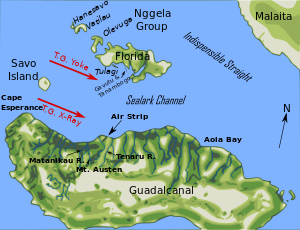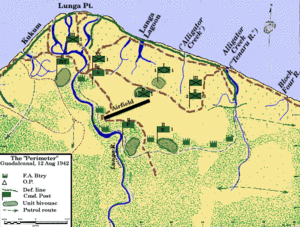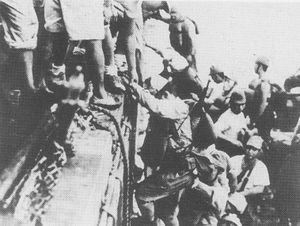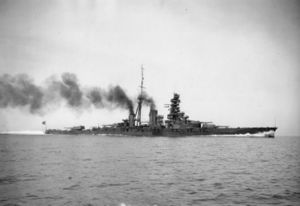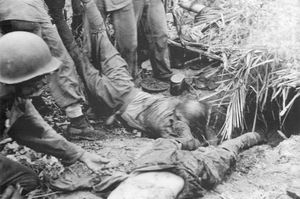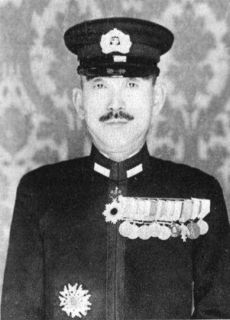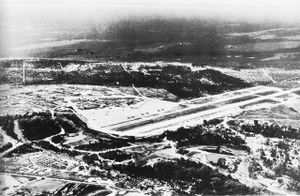حملة گوادلكانال
| Guadalcanal Campaign | |||||||
|---|---|---|---|---|---|---|---|
| جزء من the مسرح الهادي في الحرب العالمية الثانية | |||||||
 United States Marines rest in the field during the Guadalcanal campaign | |||||||
| |||||||
| المتحاربون | |||||||
|
| |||||||
| القادة والزعماء | |||||||
|
Robert L. Ghormley William F. Halsey, Jr. Richmond K. Turner Frank J. Fletcher Alexander A. Vandegrift Merritt A. Edson Alexander M. Patch |
Isoroku Yamamoto Hiroaki Abe Nobutake Kondō Nishizo Tsukahara Takeo Kurita Jinichi Kusaka Shōji Nishimura Gunichi Mikawa Raizō Tanaka Hitoshi Imamura Harukichi Hyakutake | ||||||
| القوى | |||||||
| 60,000 men (ground forces)[4] | 36,200 men (ground forces)[5] | ||||||
| الضحايا والخسائر | |||||||
|
7,100 dead 7,789+ wounded[6] 4 captured 29 ships lost 615 aircraft lost[7] |
19,200 dead
38 ships lost 683–880 aircraft lost[9] | ||||||
The Guadalcanal Campaign, also known as the Battle of Guadalcanal and codenamed Operation Watchtower was a military campaign fought between 7 August 1942 and 9 February 1943 on and around the island of Guadalcanal in the Pacific theater of World War II. It was the first major offensive by Allied forces against the Empire of Japan.
On 7 August 1942, Allied forces, predominantly United States Marines, landed on the islands of Guadalcanal, Tulagi, and Florida in the southern Solomon Islands, with the objective of denying their use by the Japanese to threaten Allied supply and communication routes between the US, Australia, and New Zealand. The Allies also intended to use Guadalcanal and Tulagi as bases to support a campaign to eventually capture or neutralize the major Japanese base at Rabaul on New Britain. The Allies overwhelmed the outnumbered Japanese defenders, who had occupied the islands since May 1942, and captured Tulagi and Florida, as well as an airfield (later named Henderson Field) that was under construction on Guadalcanal. Powerful American and Australian naval forces supported the landings.
Surprised by the Allied offensive, the Japanese made several attempts between August and November to retake Henderson Field. Three major land battles, seven large naval battles (five nighttime surface actions and two carrier battles), and continual (almost daily) aerial battles, culminated in the decisive Naval Battle of Guadalcanal in early November, in which the last Japanese attempt to bombard Henderson Field from the sea and land with enough troops to retake it was defeated. In December, the Japanese abandoned their efforts to retake Guadalcanal and evacuated their remaining forces by 7 February 1943, in the face of an offensive by the US Army's XIV Corps.
The Guadalcanal campaign was a significant strategic combined arms Allied victory in the Pacific theater. Along with the Battle of Midway, it has been called a turning point in the war against Japan.[10] The Japanese had reached the peak of their conquests in the Pacific. The victories at Milne Bay, Buna-Gona, and Guadalcanal marked the Allied transition from defensive operations to the strategic initiative in the theater, leading to offensive operations such as the Solomon Islands, New Guinea, and Central Pacific campaigns, that eventually resulted in Japan's surrender and the end of World War II.
. . . . . . . . . . . . . . . . . . . . . . . . . . . . . . . . . . . . . . . . . . . . . . . . . . . . . . . . . . . . . . . . . . . . . . . . . . . . . . . . . . . . . . . . . . . . . . . . . . . . . . . . . . . . . . . . . . . . . . . . . . . . . . . . . . . . . . . . . . . . . . . . . . . . . . . . . . . . . . . . . . . . . . . .
Background
Strategic considerations
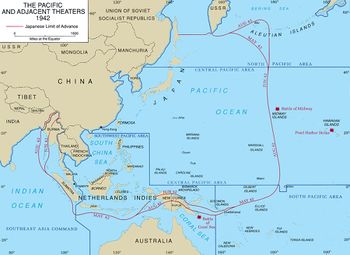
Events
Landings
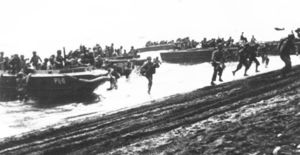
Battle of Savo Island
Initial operations
The Goettge Patrol
Battle of the Tenaru
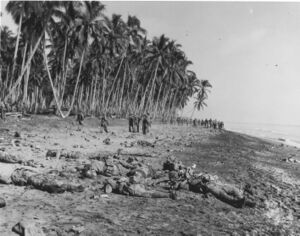
Battle of the Eastern Solomons
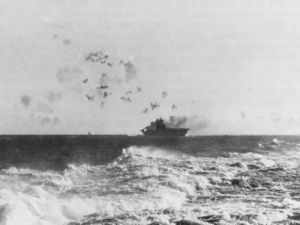
Air battles over Henderson Field and strengthening of the Lunga defenses
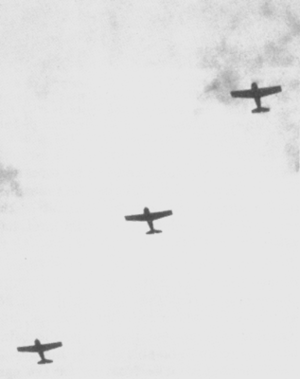
Tokyo Express
. . . . . . . . . . . . . . . . . . . . . . . . . . . . . . . . . . . . . . . . . . . . . . . . . . . . . . . . . . . . . . . . . . . . . . . . . . . . . . . . . . . . . . . . . . . . . . . . . . . . . . . . . . . . . . . . . . . . . . . . . . . . . . . . . . . . . . . . . . . . . . . . . . . . . . . . . . . . . . . . . . . . . . . .
Battle of Edson's Ridge

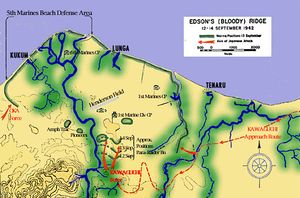
Reinforcement

Actions along the Matanikau

Battle of Cape Esperance
Henderson Field
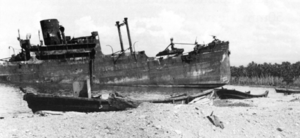
Battle for Henderson Field
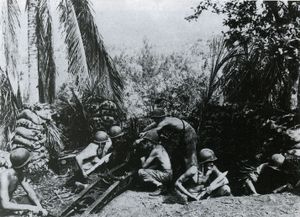
Battle of the Santa Cruz Islands

November land actions
معركة گوادالكانال البحرية
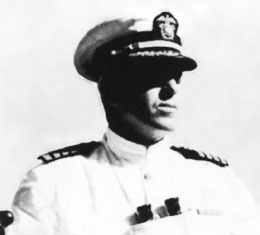
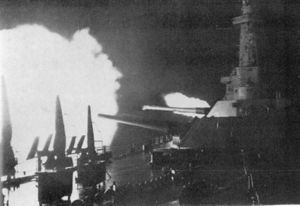
. . . . . . . . . . . . . . . . . . . . . . . . . . . . . . . . . . . . . . . . . . . . . . . . . . . . . . . . . . . . . . . . . . . . . . . . . . . . . . . . . . . . . . . . . . . . . . . . . . . . . . . . . . . . . . . . . . . . . . . . . . . . . . . . . . . . . . . . . . . . . . . . . . . . . . . . . . . . . . . . . . . . . . . .
Battle of Tassafaronga
قرار اليابان بالانسحاب
Battle of Mount Austen, the Galloping Horse, and the Sea Horse

الأعقاب

الأهمية
انظر أيضاً
الهامش
- ^ Zimmerman, pp. 173–175 documents the participation by native Solomon Islanders in the campaign [1].
- ^ Jersey, pp. 356–358. Assisting the Americans in the latter stages of campaign were Fijiian commandos led by officers and non-commissioned officers from the New Zealand Expeditionary Force.
- ^ Garamone, Jim (9 November 2010). "Mullen Thanks Tonga for Steadfast Support". U.S. Navy. Retrieved 19 August 2016.
- ^ Frank, pp. 57, 619–621; and Rottman, p. 64. Approximately 20,000 U.S. Marines and 40,000 U.S. Army troops were deployed on Guadalcanal at different times during the campaign.
- ^ Rottman, p. 65. 31,400 men Imperial Japanese Army and 4,800 men Imperial Japanese Navy troops were deployed to Guadalcanal during the campaign. Jersey claims that 50,000 total Japanese army and navy troops were sent to Guadalcanal and that most of the original naval garrison of 1,000–2,000 men was successfully evacuated in November and December 1942 by Tokyo Express warships (Jersey, pp. 348–350).
- ^ The USMC History Division states that the US ground forces (Army and Marine Corps) suffered 4,709 total wounded. Marine air units add another 127 to this figure. Frank pg. 644 notes that the Bureau of Personnel, World War II Casualty List, Books 2 and 3, Naval Historical Center, Washington, D.C. lists US Navy wounded over the course of the campaign as 2,953, but this number appears to be an understatement.
- ^ Frank, pp. 598–618; and Lundstrom, p. 456. 85 Australians were killed in the Battle of Savo Island. Total Solomon Islander deaths are unknown. Most of the rest, if not all, of those killed were American. Numbers include personnel killed by all causes including combat, disease, and accidents. Losses include 1,768 dead (ground), 4,911 dead (naval), and 420 dead (aircrew). Four U.S. aircrew were captured by the Japanese during the Battle of the Santa Cruz Islands and survived their captivity. An unknown number of other U.S. ground, naval, and aircrew personnel were, according to Japanese records, captured by Japanese forces during the campaign but did not survive their captivity and the dates and manners of most of their deaths are unknown (Jersey, pp. 346, 449). Captured Japanese documents revealed that two captured Marine scouts had been tied to trees and then vivisected while still alive and conscious by an army surgeon as a medical demonstration (Clemens, p. 295). Ships sunk includes both warships and "large" auxiliaries. Aircraft destroyed includes both combat and operational losses.
- ^ Cowdrey (1994) pg. 71, "Of the 19,200 dead, only 8,500 were 'killed in actual combat,' the majority perishing by malnutrition, malaria, diarrhea, and beriberi." Naval personnel deaths both on land and at sea are not factored into this total.
- ^ Frank, pp. 598–618, Shaw, p. 52, and Rottman, p. 65. Numbers include personnel killed by all causes including combat, disease, and accidents. Losses include 24,600–25,600 dead (ground), 3,543 dead (naval), and 2,300 dead (aircrew). Most of the captured personnel were Korean slave laborers assigned to Japanese naval construction units. Ships sunk includes warships and "large" auxiliaries. Aircraft destroyed includes both combat and operational losses.
- ^ Parshall, Jon. "Title". combinedfleet.com. Retrieved 23 September 2016.
المراجع
الكتب
- Alexander, Joseph H. Edson's Raiders: The 1st Marine Raider Battalion in World War II. Annapolis, MD.: Naval Institute Press, 2000. ISBN 1-55750-020-7 OCLC 44764056
- Bergerud, Eric M. Touched with Fire: The Land War in the South Pacific. NEw York: Penguin Books,1997. ISBN 0-14-024696-7 OCLC 37137722
- Clemens, Martin. Alone on Guadalcanal: A Coastwatcher's Story. Annapolis, MD.: Naval Institute Press, 2004. ISBN 1-59114-124-9 OCLC 54687505
- Cowdrey, Albert (1994). Fighting for Life: American Military Medicine in World War II. New York: The Free Press. ISBN 0-684-86379-0.
- Crenshaw, Russell Sydnor. South Pacific Destroyer: The Battle for the Solomons from Savo Island to Vella Gulf. Annapolis, MD.: Naval Institute Press, 1998. ISBN 1-55750-136-X OCLC 38527912
- Dull, Paul S. A Battle History of the Imperial Japanese Navy, 1941–1945. Annapolis, MD.: Naval Institute Press, 1978. ISBN 0-87021-097-1 OCLC 3773679
- Evans, David C. The Japanese Navy in World War II: In the Words of Former Japanese Naval Officers. Annapolis, MD.: Naval Institute Press, 1986. ISBN 0-87021-316-4 OCLC 13560220
- Dyer, George Carroll (1972). The Amphibians Came to Conquer: The Story of Admiral Richmond Kelly Turner (PDF). Fleet Marine Force Reference Publication (FMFRP 12-109-11). Vol. 1. Washington: Department of the Navy. LCCN 71603853. Retrieved 18 August 2015.
- Frank, Richard. Guadalcanal: The Definitive Account of the Landmark Battle. New York: Random House, 1990. ISBN 0-394-58875-4 OCLC 21229351
- Gilbert, Oscar E. Marine Tank Battles of the Pacific. Conshohocken, PA.: Combined Pub., 2001. ISBN 1-58097-050-8 OCLC 45917262
- Griffith, Samuel B. The Battle for Guadalcanal. Champaign, IL: University of Illinois Press, 2000. ISBN 0-252-06891-2 OCLC 43555161
- Hadden, Robert Lee. 2007. "The Geology of Guadalcanal: a Selected Bibliography of the Geology, Natural History, and the History of Guadalcanal." Alexandria, Virginia: Topographic Engineering Center. 360 pages. Lists sources of information regarding the bodies of the US Marines of the Lt Col. Frank B. Goettge Reconnaissance patrol that was ambushed in August 1942.
- Hammel, Eric. Carrier Clash: The Invasion of Guadalcanal & The Battle of the Eastern Solomons August 1942. St. Paul, MN.: Zenith Press, 2004. ISBN 0-7603-2052-7 OCLC 56642994
- Hammel, Eric. Carrier Strike: The Battle of the Santa Cruz Islands, October 1942. Pacifica, CA.: Pacifica Press, 2000. ISBN 0-935553-37-1 OCLC 42812897
- Hara, Tameichi. Japanese Destroyer Captain. New York: Ballantine Books, 1961. OCLC 1070440
- Hayashi, Saburo. Kogun: The Japanese Army in the Pacific War. Quantico: Marine Corps Association, 1959. OCLC 464063302
- Hornfischer, James D. Neptune's Inferno: The U.S. Navy at Guadalcanal. New York: Bantam Books, 2011 ISBN 0-553-80670-X OCLC 613432356
- Jersey, Stanley Coleman. Hell's Islands: The Untold Story of Guadalcanal. College Station: Texas A & M University Press, 2008. ISBN 1-58544-616-5 OCLC 122526828
- Kilpatrick, C. W. Naval Night Battles of the Solomons. Pompano Beach, FL.: Exposition Press of Florida, 1987. ISBN 0-682-40333-4 OCLC 16874430
- Loxton, Bruce and Chris Coulthard-Clark. The Shame of Savo: Anatomy of a Naval Disaster. St. Leonards, N.S.W.: Allen & Unwin, 1997. ISBN 1-86448-286-9 OCLC 38759272
- Lundstrom, John B. The First Team And the Guadalcanal Campaign: Naval Fighter Combat from August to November 1942. Annapolis, MD.: Naval Institute Press, 2005. ISBN 1-61251-165-1 OCLC 847527705
- Manchester, William. Goodbye, Darkness A Memoir of the Pacific. Boston: Little, Brown and Company, 1980. ISBN 0-316-54501-5 OCLC 6421928
- McGee, William L. The Solomons Campaigns, 1942–1943: From Guadalcanal to Bougainville—Pacific War Turning Point, Volume 2. Santa Barbara, CA.: BMC Publications, 2002. ISBN 0-9701678-7-3 OCLC 49317834
- Miller, Thomas G. The Cactus Air Force. Fredericksburg, TX.: Admiral Nimitz Foundation, 1969. OCLC 31392623
- Morison, Samuel Eliot The Struggle for Guadalcanal, August 1942 – February 1943, vol. V of History of United States Naval Operations in World War II. Boston: Little, Brown and Company, 1969. OCLC 861242021
- Morison, Samuel Eliot, Breaking the Bismarcks Barrier, 22 July 1942 — 1 May 1944, vol. VI of History of United States Naval Operations in World War II. Boston: Little, Brown and Company 1950.
- Murray, Williamson and Allan R. Millett A War To Be Won: Fighting the Second World War. Cambridge, Mass.: Belknap Press of Harvard University Press, 2000. ISBN 0-674-00680-1 OCLC 43109827
- Peatross, Oscar F. Bless 'em All: The Raider Marines of World War II. Irvine, CA.: ReView Publications, 1995. ISBN 0-9652325-0-6 OCLC 35363398
- Rottman, Gordon L. Japanese Army in World War II: The South Pacific and New Guinea, 1942–43. Oxford: Osprey, 2005. ISBN 1-84176-870-7 OCLC 61879308
- Smith, Michael T. Bloody Ridge: The Battle That Saved Guadalcanal. Novato, CA.: Pocket Books, 2003. ISBN 0-7434-6321-8 OCLC 51645288
- Toland, John The Rising Sun: The Decline and Fall of the Japanese Empire, 1936–1945. New York: Modern Library, 2003. ISBN 0-8129-6858-1 OCLC 52441692
الوب
- Anderson, Charles R. (1993). Guadalcanal. The U.S. Army Campaigns of World War II. United States Army Center of Military History. Retrieved 9 July 2006.
- Bullard, Steven (translator) (2007). Japanese army operations in the South Pacific Area New Britain and Papua campaigns, 1942–43. Senshi Sōshō (translated excerpts). Canberra: Australian War Memorial. ISBN 978-0-9751904-8-7.
{{cite book}}:|first=has generic name (help) - Hough, Frank O.; Ludwig, Verle E.; Shaw, Henry I., Jr. (n.d.). "Pearl Harbor to Guadalcanal". History of U.S. Marine Corps Operations in World War II. Retrieved 16 May 2006.
{{cite web}}: CS1 maint: multiple names: authors list (link) - Miller, John, Jr. (1959). "Cartwheel: The Reduction of Rabaul". United States Army in World War II: The War in the Pacific. Office of the Chief of Military History, U.S. Department of the Army. p. 418. Retrieved 20 October 2006.
{{cite web}}: CS1 maint: multiple names: authors list (link) - Miller, John Jr. (1995) [1949]. Guadalcanal: The First Offensive. United States Army Center of Military History. Retrieved 4 July 2006.
{{cite book}}:|work=ignored (help) - Parshall, Jon; Bob Hackett; Sander Kingsepp; Allyn Nevitt. "Imperial Japanese Navy Page (Combinedfleet.com)". Retrieved 14 June 2006.
- Shaw, Henry I. (1992). "First Offensive: The Marine Campaign For Guadalcanal". Marines in World War II Commemorative Series. Retrieved 25 July 2006.
- U.S. Navy. "Chapter XXV: Campaign in the Solomons". Building the Navy's Bases in World War II: History of the Bureau of Yards and Docks and the Civil Engineer Corps, 1940–1946. U.S. Department of the Navy, Bureau of Yards and Docks. Retrieved 8 December 2006.
- Zimmerman, John L. (1949). "The Guadalcanal Campaign". Marines in World War II Historical Monograph. Retrieved 4 July 2006.
للاستزادة
الكتب
- Bartsch, William H. (2014). Victory Fever on Guadalcanal. Texas A&M University Press. ISBN 1-62349-184-3.
- Braun, Saul M. The Struggle for Guadalcanal (American Battles and Campaigns). New York: Putnam, 1969. OCLC 27157
- Christ, James F. Battalion of the Damned: The 1st Marine Paratroopers at Gavutu and Bloody Ridge, 1942. Annapolis, MD: Naval Institute Press, 2007. ISBN 1-59114-114-1 OCLC 71946979
- Coggins, Jack The Campaign for Guadalcanal;: A Battle That Made History. Garden City, NY: Doubleday and Co., 1972. ISBN 0-385-04354-6 OCLC 483439
- Crawford, John New Zealand's Pacific Frontline: Guadalcanal-Solomon Islands Campaign, 1942–45. [New Zealand]: New Zealand Defence Force, 1992. ISBN 0-473-01537-4 OCLC 27363777
- D'Albas, Andrieu. Death of a Navy: Japanese Naval Action in World War II. New York: Devin-Adair Co., 1957. OCLC 464407286
- DeBlanc, Jefferson Guadalcanal Air War:Col. Jefferson DeBlanc's Story. Gretna, LA: Pelican Pub., 2008. ISBN 1-58980-587-9 OCLC 185031258
- Farrington, Arthur C. The Leatherneck Boys: A Pfc at the Battle for Guadalcanal. Manhattan, Kan.: Sunflower University Press, 1995. ISBN 0-89745-180-5 OCLC 32349291
- Feldt, Eric Augustus. The Coastwatchers. Ringwood, Victoria, Australia: Penguin Books, 1991. ISBN 0-14-014926-0 OCLC 27488029
- Hersey, John Into the Valley: Marines at Guadalcanal. Lincoln: University of Nebraska Press, 2002. ISBN 0-8032-7328-2 OCLC 48941819
- Hornfischer, James D. Neptune's Inferno: The U.S. Navy at Guadalcanal. New York: Bantam Books ISBN 0-553-80670-X OCLC 613432356
- Hoyt, Edwin P. Guadalcanal.New York: Military Heritage Press, 1988. ISBN 0-88029-184-2 OCLC 19293942
- Hubler, Richard G., and John A. Dechant. Flying Leathernecks. Garden City, New York: Doubleday, Doran & Co., 1944. OCLC 494189806
- Leckie, Robert. Helmet for my Pillow. [S.l.]: Ibooks, 2006. ISBN 1-59687-092-3 OCLC 173166880
- Leckie, Robert Challenge for the Pacific: The Bloody Six-Month Battle Of Guadalcanal. New York: Da Capo Press, 1999. ISBN 0-306-80911-7 OCLC 40126887
- Letourneau, Roger; Letourneau, Dennis (2012). Operation Ke: The Cactus Air Force and the Japanese Withdrawal from Guadalcanal. Annapolis, MD: Naval Institute Press. ISBN 978-1-59114-446-5.
- Lord, Walter. Lonely Vigil: Coastwatchers of the Solomons. Annapolis, MD: Naval Institute Press, 2006. ISBN 1-59114-466-3 OCLC 70045788
- Lundstrom, John B. Black Shoe Carrier Admiral: Frank Jack Fletcher at Coral Seas, Midway & Guadalcanal. Annapolis, MD.: Naval Institute Press, 2006. ISBN 1-59114-475-2 OCLC 62782215
- Marion, Ore J., Thomas Cuddihy and Edward Cuddihy. On the Canal: The Marines of L-3-5 on Guadalcanal, 1942. Mechanicsburg, PA: Stackpole Books, 2004. ISBN 0-8117-3149-9 OCLC 53374983
- Merillat, Herbert Christian. Guadalcanal Remembered. Tuscaloosa: University Alabama Press, 2003 ISBN 0-8173-1290-0 OCLC 50559909
- Merillat, Herbert L. The Island: A History of the First Marine Division on Guadalcanal, August 7 – December 9, 1942. Boston: Houghton Mifflin Company, 1944. OCLC 487310466
- Miller Jr., John. Guadalcanal: The First Offensive. Washington, D.C.: United States Army Center of Military History, 1995. ISBN 0-16-001908-7 OCLC 52642465
- Mueller, Joseph. Guadalcanal 1942: The Marines Strike Back. London: Osprey, 1992. ISBN 1-85532-253-6 OCLC 28111740
- Parkin, Robert Sinclair. Blood on the Sea: American Destroyers Lost in World War II. Cambridge, MA: Da Capo Press, 1995. ISBN 0-306-81069-7 OCLC 48497788
- Poor, Henry V., Henry A. Mustin and Colin G. Jameson. The Battles of Cape Esperance, 11 October 1942 and Santa Cruz Islands, October 26, 1942. Washington, DC: Naval Historical Center, 1994. ISBN 0-945274-21-1 OCLC 29031302
- Radike, Floyd W. Across the Dark Islands: The War in the Pacific. New York: Presidio, 2003. ISBN 0-89141-774-5 OCLC 53289933
- Richter, Don. Where the Sun Stood Still: The Untold Story of Sir Jacob Vouza and the Guadalcanal Campaign. Calabasas, CA: Toucan Pub., 1992. ISBN 0-9611696-3-X OCLC 27771674
- Rose, Lisle Abbott. The Ship that Held the Line: The USS Hornet and the First Year of the Pacific War. Annapolis, MD: Naval Institute Press, 2002. ISBN 1-55750-008-8 OCLC 48507810
- Rottman, Gordon L. and Duncan Anderson. U.S. Marine Corps Pacific Theater of Operations 1941–43. Oxford: Osprey, 2004. ISBN 1-84176-518-X OCLC 53459823
- Smith, George W. The Do-or-Die Men: The 1st Marine Raider Battalion at Guadalcanal. New York: Pocket Books, 2003. ISBN 0-7434-7005-2 OCLC 53009145
- Stafford, Edward Peary. The Big E: The Story of the USS Enterprise. Annapolis, MD.: Naval Institute Press, 2002. ISBN 1-55750-998-0 OCLC 48493709
- Tregaskis, Richard. Guadalcanal Diary. New York: Modern Library, 2000. ISBN 0-679-64023-1 OCLC 43109810
- Twining, Merrill B. No Bended Knee: The Battle for Guadalcanal. Novato, CA.: Presidio, 1996. ISBN 0-89141-549-1 OCLC 503599358
- Ulbrich, David J. Preparing for Victory: Thomas Holcomb and the Making of the Modern Marine Corps, 1936–1943. Annapolis, MD.: Naval Institute Press, 2011. ISBN 1-59114-903-7 OCLC 670481778
- Walker, Charles H. Combat Officer: A Memoir of War in the South Pacific. New York: Presidio, 2004. ISBN 0-345-46385-4 OCLC 56656650
- Werstein, Irving. Guadalcanal. 1963. OCLC 641130630
الوب
- Australian War Memorial (n.d.). "Secondary Bibliography by Author" (bibliography of Japanese-language sources). Australia-Japan Research Project. Retrieved 6 November 2008.
- Burbeck, James (2008). "The Guadalcanal Campaign". Flash animated combat map series at The War Times Journal.
- Cagney, James. "An Animated Map History of the Battle for Guadalcanal". HistoryAnimated.com. Retrieved 4 September 2008.
- Craven, Wesley Frank; James Lea Cate. "Vol. IV, The Pacific: Guadalcanal to Saipan, August 1942 to July 1944". The Army Air Forces in World War II. U.S. Office of Air Force History. Retrieved 20 October 2006.
- Donahue, PFC James A. Guadalcanal Journal.
- Dillard, Nancy R. (20 May 1997). "Operational Leadership: A Case Study of Two Extremes during Operation Watchtower" (Academic report). Joint Military Operations Department, Naval War College. Retrieved 4 August 2009.
- Dyer, George Carroll. "The Amphibians Came to Conquer: The Story of Admiral Richmond Kelly Turner". United States Government Printing Office. Retrieved 20 October 2006.
- Emberton, Keith D. (1 May 1996). "Operational Leadership Once Beyond the Culminating Point: Perspectives on Calculated Tactical Risk to Achieve Operational Success" (Academic report). Joint Military Operations Department, Naval War College. Retrieved 4 August 2009.
- Garrett, James R. "James R. "Rube" Garrett A Marine Diary: My Experiences on Guadalcanal". An Eyewitness Account of the Battle of Guadalcanal. Archived from the original on 11 February 2007.
{{cite web}}: Unknown parameter|deadurl=ignored (|url-status=suggested) (help) - Gillespie, Oliver A. (1952). "The Official History of New Zealand in the Second World War, 1939–1945; The Battle for the Solomons (Chapter 7)". New Zealand Electronic Text Center. Retrieved 11 July 2006.
- Hoffman, Jon T. (1995). "From Makin to Bougainville: Marine Raiders in the Pacific War" (brochure). World War II Commemorative Series. Marine Corps Historical Center. Retrieved 29 August 2006.
- Hoffman, Jon T. "Silk Chutes and Hard Fighting: U.S. Marine Corps Parachute Units in World War II" (PDF). Commemorative series. Marine Corps History and Museums Division. p. 1. Retrieved 26 December 2006.
- Mersky, Peter B. (1993). "Time of the Aces: Marine Pilots in the Solomons, 1942–1944". Marines in World War II Commemorative Series. History and Museums Division, Headquarters, U.S. Marine Corps. Retrieved 20 October 2006.
- Newell, Clayton R. (2003). "Central Pacific". The U.S. Army Campaigns of World War II. United States Army Center of Military History. Retrieved 6 August 2008.
- Japanese Operations in the Southwest Pacific Area, Volume II – Part I. United States Army Center of Military History. Retrieved 8 December 2006.
{{cite book}}:|work=ignored (help) – Translation of the official record by the Japanese Demobilization Bureaux detailing the Imperial Japanese Army and Navy's participation in the Southwest Pacific area of the Pacific War. - U.S. Army Air Forces (1992). "Pacific Counterblow: The 11th Bombardment Group and the 67th Fighter Squadron in the Battle for Guadalcanal". Wings at War (Reissue ed.). Office of Assistant Chief of Air Staff, Intelligence. Retrieved 8 December 2006.
Audio/visual
- Adams, M. Clay (Director) (1952). Victory at Sea- Episode 6: Guadalcanal (Video documentary). National Broadcasting Company (NBC) Film. One episode from a 26-episode series about naval combat during World War II.
- Malick, Terrence (Director) (1998). The Thin Red Line (Feature-length film). 20th Century Fox Home Entertainment. Film adaptation of James Jones' fictional, dramatic novel of the same title set on Guadalcanal.
- Marton, Andrew (Director) (1964). The Thin Red Line (Feature-length film). Allied Artists Pictures. Film adaptation of James Jones' fictional, dramatic novel of the same title set on Guadalcanal.
- Montgomery, Robert (Director) (1960). The Gallant Hours (Feature-length film). United Artists. Biographical film about Admiral Halsey during the Guadalcanal campaign.
- Ray, Nicholas (Director) (1951). Flying Leathernecks (Feature-length film). RKO Radio Pictures. Fictional drama about U.S. Marine pilots involved in the Battle of Guadalcanal.
- Seiler, Lewis (Director) (1943). Guadalcanal Diary (Feature-length film). 20th Century Fox Film Corporation. Film adaptation of Tregaskis' book referenced in "Books" section above.
- Van Patten, Tim (Director) (2010). The Pacific (TV Miniseries). HBO, Seven Network, DreamWorks. "Part One" and "Part Two" deal with the Guadalcanal campaign.
- Video including historical footage of the Battle for Guadalcanal
- Shootout! Season 1, Guadalcanal (TV series).
- The Lost Evidence Episode 20 (TV series).
وصلات خارجية
- Panel discussion on the 132nd Infantry Regiment at Guadalcanal at the Pritzker Military Museum & Library
- Report on operations and tactics at Lonesentry.com
- Guadalcanal Odyssey (1975)
9°26′44″S 160°01′13″E / 9.44556°S 160.02028°E
[[تصنيف:معارك الحرب العالمية الثانية التي شاركت فيها المملكة المتحدة ]]
- Pages using gadget WikiMiniAtlas
- Articles with hatnote templates targeting a nonexistent page
- CS1 errors: generic name
- CS1 errors: periodical ignored
- CS1 errors: unsupported parameter
- Coordinates on Wikidata
- مقالات مميزة
- حملة گوادالكانال
- 1942 في اليابان
- 1942 في جزر سليمان
- 1943 في اليابان
- 1943 في جزر سليمان
- Battles and operations of World War II involving the Solomon Islands
- Battles of World War II involving Australia
- Battles of World War II involving Japan
- حملات الحرب العالمية الثانية
- نزاعات 1942
- نزاعات 1943
- گوادالكانال
- Pacific Ocean theatre of World War II
- United States Marine Corps in World War II
- عمليات ومعارك الحرب العالمية الثانية في مسرح المحيط الهادي
- World War II sites in the Solomon Islands
- حملات وعمليات ومعارك الحرب العالمية الثانية التي شاركت فيها المملكة المتحدة
- عمليات برمائية في الحرب العالمية الثانية
